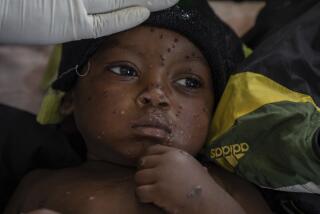Baby ‘cured’ of HIV: New details offer hope for other patients
New details about the first person to be cured of HIV through drug therapy alone offer hope that others who are born with the virus may be able to beat it back and avoid a lifetime of treatment, researchers reported Wednesday.
The formerly HIV-positive Mississippi girl drew widespread interest in March when doctors presented her case in March at a medical meeting in Atlanta. Now they have published a full account of the girl’s treatment and recovery in New England Journal of Medicine.
The 3-year-old girl has not taken any antiretroviral drugs for at least 18 months – yet tests find “no detectable level of HIV-1 RNA” in her blood, according to the report.
The only other person considered functionally cured of HIV is Timothy Ray Brown, also known as the “Berlin patient.” Brown’s cure was brought about by more radical means – a bone marrow transplant. He needed the transplant because he had acute myeloid leukemia, and his doctors used it as an opportunity to find a donor who had a rare genetic mutation that blocks HIV from entering cells.
But there are several reasons why this approach can’t be extended to the estimated 34 million people worldwide who are HIV-positive. For one, bone marrow transplants are risky. The risk of death is acceptable for patients with cancer but not for patients with HIV who can control their infection with drugs, doctors say.
Also, very few patients would be able to find a bone marrow donor who is a match for their immune system and who also has the genetic mutation that keeps HIV at bay. Researchers are trying to introduce the rare mutation directly to patients using gene therapy, though more research is needed before clinical trials can begin.
The girl’s case is enticing because her cure came about through antiretroviral drug treatment, or ART. Experts suspect that the three-drug cocktail was so successful because it prevented HIV from establishing itself in the patient’s immune system. Once the virus digs in, it evades drugs and remains dormant until the opportunity arises to strike again.
Thanks to preventive treatments, babies born with HIV are rare in the U.S. – the Centers for Disease Control and Prevention said that fewer than 200 infants were infected at birth in 2010. But around the world, about 1,000 babies are born with the virus every day, experts estimate. Those are the patients who stand to gain from the unintentional experiment involving the Mississippi girl, according to the authors of the New England Journal of Medicine report.
The girl’s doctors didn’t stop her treatment to see if she could get along without her drugs, because a test like that would have been considered unethical. Instead, the mother stopped filling the girl’s prescriptions when she was 15 months old. She also told doctors her daughter hadn’t taken the ART drugs since she was 18 months old.
Five months later, the girl came to a clinic for a checkup. Her doctors expected to find that her viral load, which had been undetectable since she was 29 days old, had built back up. But blood tests found no signs of the virus – a complete surprise.
The results were confirmed by additional blood tests. No HIV antibodies were found in samples drawn when the girl was 24, 26 and 28 months old, according to the New England Journal of Medicine report. A single copy of viral RNA was found in blood plasma drawn when the girl was 24 months old, but ultra-sensitive tests failed to detect any copies two months later.
“At the age of 36 months, at least 18 months after the cessation of ART, the child has no detectable level of HIV-1 RNA,” the authors wrote.
When the girl’s case was first announced, some doctors wondered whether the child really had HIV in the first place. The New England Journal of Medicine report offers much evidence that she was infected in utero. A blood sample drawn 30 hours after birth contained HIV-1 DNA. Another sample drawn an hour later had enough HIV RNA – 19,812 copies per milliliter of blood – to qualify for an HIV-positive diagnosis.
Doctors initially treated the baby with a three-drug cocktail that included zidovudine, lamivudine and nevirapine. Her first doses were administered when she was 30 hours old. After one week, doctors switched her from nevirapine to ritonavir-boosted lopinavir. As treatment continued, her viral load declined in a manner “similar to that described previously in HIV-1 infected infants and adults receiving ART,” they wrote.
Back in March, some experts also wondered whether the girl happened to have the rare mutation that makes people naturally immune to HIV. She does not, according to the study.
The doctors also noted that the girl’s “growth and development have been normal.”
The girl’s case supports the idea that starting antiretroviral therapy very soon after birth prevents the virus from getting any traction in the immune system, the report’s authors concluded. Further studies already in the planning stages might be able to show that the strategy can spare infected infants from “a lifetime of therapy,” they concluded.
If you’re interested in the latest developments in medicine, you’re interested in the things I write about. Follow me on Twitter and “like” Los Angeles Times Science & Health on Facebook.
ALSO:
Surgery trounces diet and exercise for treating obesity and its ills
Time to end the war against saturated fat?
Flu shots may reduce risk of heart attacks, strokes and even death







